learning_to_draw_02: AI-Powered G-Code Generation for Machine Drawing
Introduction
Building on my previous work with machine drawing, I’m excited to share my latest project: learning_to_draw_02. This initiative explores the intersection of artificial intelligence and creative expression through the lens of G-code generation for 2D plotters and 3D printers.
Project Overview
The core concept of learning_to_draw_02 is to harness the power of state-of-the-art open-source AI models to create a Large Language Model (LLM) capable of generating G-code from images. This approach offers a novel way to translate visual information into machine instructions for drawing or printing.
Key Components
-
Dataset Creation: I’ve developed a procedural method to generate paired datasets of images and their corresponding G-code instructions.
-
AI Model Training: The project utilizes a vision transformer neural network, trained to take an image as input and produce the G-code required to draw that image.
-
Development Process: I leveraged AI assistance in the coding process, using ChatGPT for quick suggestions and Claude.ai for more in-depth debugging and refinement.
Technical Implementation
The heart of the project lies in creating a multi-modal image-to-text model using the Hugging Face ecosystem. This involves:
- Defining a vision transformer model
- Training on the custom dataset of images and G-code pairs
- Utilizing the HUGGINGFACE_API_KEY for seamless integration
Future Directions
As the project evolves, I’m considering additional features such as:
- A G-code to PNG turtle image renderer
- Potential blockchain integration for image verification and provenance
Conclusion
learning_to_draw_02 represents an exciting step forward in the realm of AI-assisted creative tools. By bridging the gap between visual input and machine instructions, this project opens up new possibilities for artists, makers, and researchers interested in computational creativity.
I look forward to sharing more updates as the project progresses and exploring the potential applications of this technology in various fields.
Thanks Claude.
